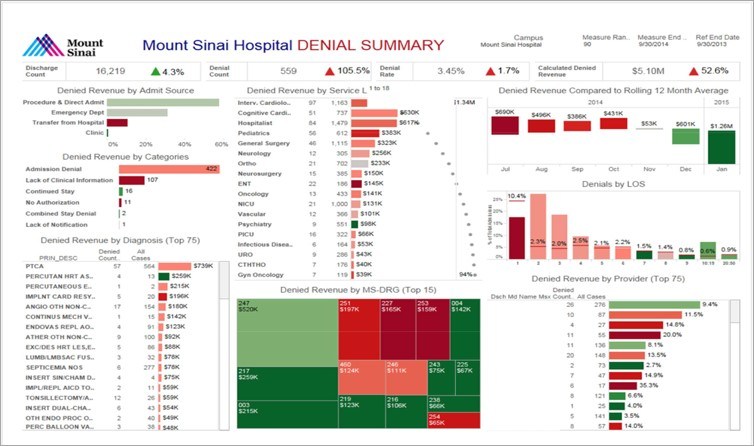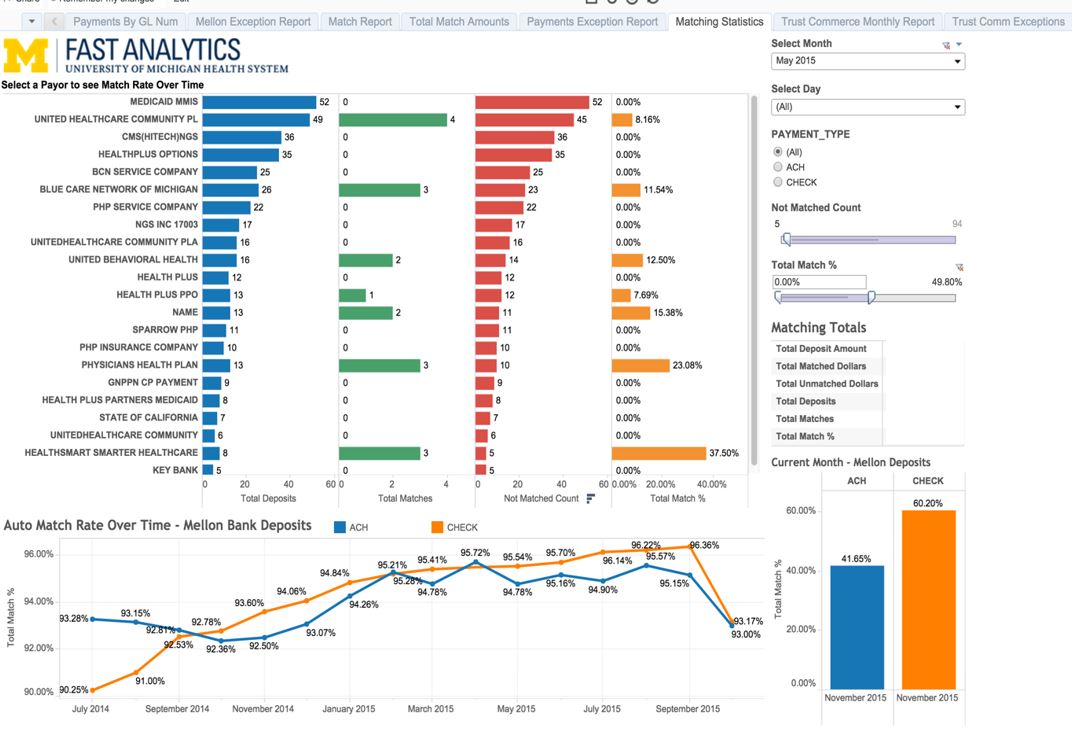3 ways visual analytics supports RCM success
Forward-looking healthcare organizations aspire to exploit the potential of their data across every area of their operations, from diagnostics to customer service—but it’s clear that revenue cycle management (RCM) is one area where data and actionable analytics can make an immediate, measurable impact.
With the ability to aggregate data from all of your EHRs, ERP, RCM, medical billing, and other healthcare information technology (HIT) systems and create relevant visualizations and dashboards, you’re finally able to connect the dots. Insights into billing, claims, contract analysis, coding and ICD-10 requirements, and clinical documentation gives you a 360-degree view that helps you identify patterns and respond appropriately.
End-to-end visibility also gives leadership what they need the most: the ability to create role-based reports based on near real time analyses, capturing trends and insights that empower CFOs, RCM leadership, analysts and others to make better decisions.
Without a cohesive view of your data, your organization—and your revenue cycle—is at risk. Lost time, wasted resources, and delayed resolution of even the most basis queries are all drags on productivity and profit. Furthermore, opportunities for process improvement and collaboration are lost when you don’t understand the nuances and can’t see the big picture.
This blog post looks at three key use cases and real-world success stories where self-service visual analytics is driving higher RCM efficiency and productivity.
Optimizing denials management to minimize revenue leakage
The organization: Mount Sinai Health System
The result: Saved $100 MM+ from optimal denials management
Mount Sinai Health System is one of the largest healthcare systems in the U.S., serving one of the most diverse populations in the world. With over 136,000 inpatient admissions and more than 3,100,000 outpatient visits to offices and clinics, revenue cycle management at scale is an enterprise imperative.
Substantial revenue opportunity revealed
An emergency department physician working with denials management data (Figure 1, below) created the first-ever interactive dashboard, and identified $125 MM in sub-optimal denials management opportunities that the CFO’s office had missed.

Drill downs and root-cause analysis helped identify over $100 MM in revenue opportunities
Proactive expense variance analysis reduces waste and avoidable expenses
The organization: Stamford Health System
The result: Reduced avoidable expenses and supplier price creep through reduction in expense variance
Stamford Health is an independent community hospital with 305 beds and 125 physicians. Like all community hospitals, Stamford is under pressure to deliver high-quality, cost-effective care in a highly competitive environment.
Manual data collection, disconnected systems, and spreadsheet-based reporting made it difficult to gain insight into processes and make improvements. Without a unified data platform, Stamford had no way to track clinical, operational, or RCM efficiencies using pertinent metrics or make much progress against Lean Six Sigma goals to enable continuous improvement.
Going beyond spreadsheet solutions
After implementing Tableau, Stamford RCM executives, business leaders, and analysts had the power to access the right data at the right time and to proactively dentify variances in expenses and pricing creep from suppliers.
By the numbers
Stamford Health saved $6.5 million improving its clinical, operational, and RCM initiatives and over $3 million from its value analysis.

Automating manual RCM tasks to drive measurable improvements in employee productivity and morale
Enabling RCM efficiencies and productivity through visual analytics-enabled automation
The organization: Michigan Medicine
The result: Saved over 10,000 hours of manual tasks, and improved employee productivity and morale
Michigan Medicine is home to one of the largest health care complexes in the world, with three hospitals, 40 outpatient hospitals, and more than 140 clinics. Michigan Medicine’s Fast Analytics team, part of the Revenue Cycle Management Department, serves the data needs of over 30 internal groups. With Tableau, these 30 teams are able to allocate resources more efficiently—what was siloed information is now accessible, informing faster decision-making across the enterprise.
Visual analytics unlocks new efficiencies
Michigan Medicine has achieved numerous process and productivity milestones since implementing Tableau, including saving 10,000 cumulative hours of manual work. Among the most significant milestones:
- Automated reporting saved over 5,000 hours on four different projects
- 19 groups eliminated 48 hours of work per week with access to common dashboard
- Charge estimation dashboard accelerates a 4.5-hour process into a 4.5 second query
- 85-92% of reconciliation process is now automated, providing a baseline to reconcile the rest

Before Tableau implementation, only 13% of accounts were being reconciled—manually. Today, reconciliation is automated at a rate of 96%-97%.
Related Stories
Subscribe to our blog
Get the latest Tableau updates in your inbox.









